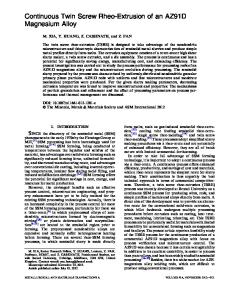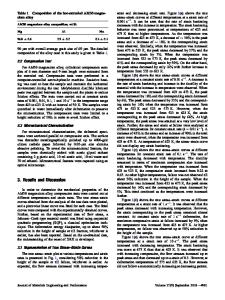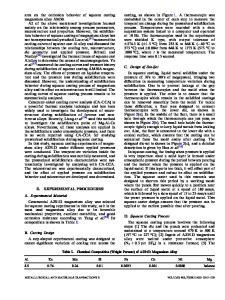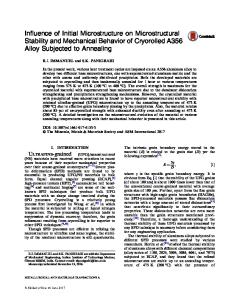Mechanical behavior and microstructural characteristics of magnesium alloy containing {10-12} twin lamellar structure
- PDF / 655,234 Bytes
- 7 Pages / 584.957 x 782.986 pts Page_size
- 49 Downloads / 403 Views
A hot-rolled AZ31 Mg alloy sheet was subjected to dynamic plastic deformation parallel to the rolling direction with the aim of introducing {10-12} twins. Subsequent tensile tests were carried out along the predeformed direction and the initial transverse direction (TD). It was found that untwinning led to a significant drop in yield stress when tension is carried out along the predeformed direction. And {10-12} twins and strain caused by twinning were recovered by untwinning. The tensile yield stress increased slightly with prestrain was correlated with the texture hardening caused by untwinning. When tension is carried out along initial TD, {10-12} twinning activity was restrained and slip dominated plastic deformation. The tensile yield stress increased significantly with prestrain was strongly correlated with the hardening contributions of {10-12} twins. {10-12} twinning led to the obvious yield stress in-plane anisotropy but had little effect on the maximum flow stress.
I. INTRODUCTION
Due to the characteristic of the hexagonal crystal lattice, magnesium alloys have the limited number of slip systems, which result in the poor formability at room temperature. And the crystallographic texture always forms upon mechanical processing and leads to a pronounced anisotropy of the mechanical properties of magnesium alloys.1–4 Possible deformation mechanisms in Mg alloys include basal slip, prismatic slip, pyramidal slip, and several twinning modes, and this anisotropy is further reflected in the polarity of {10-12} twinning, which only allows shear in one direction rather than opposite directions.5 Meanwhile, twinning mechanism has a significant effect on mechanical properties of the wrought Mg alloys. Under certain loading conditions (i.e., tension parallel to the c-axis of the crystal lattice or compression perpendicular to the c-axis), {10-12} twinning will dominate deformation and lead to a relatively low yield stress at the early stages of deformation.6–10 And strengthening mechanisms related to {10-12} twinning also play an important role in improving mechanical properties of materials.11–14 Due to the polarity characteristic, twins can disappear or become narrower under reverse loading or reloading. This process is referred to as untwinning (or detwinning). Untwinning behavior has been extensively investigated over the past years.14–17 Untwinning is considered as the reverse process of twinning and is different from twinning in some respects. First, it is the process without twinning nucleation; second, the activated stress required for untwina)
Address all correspondence to this author. e-mail: [email protected] DOI: 10.1557/jmr.2012.394 J. Mater. Res., Vol. 28, No. 5, Mar 14, 2013
ning is less than that for twinning nucleation but greater than that for twinning growth.18 In this study, we investigated the mechanical behavior and the microstructural evolution of Mg alloy containing {10-12} twin lamellar structureand analyzed the effects of twinning strengthening and “untwinning strengthening” on the mechanical p
Data Loading...











